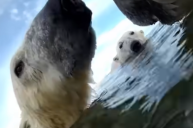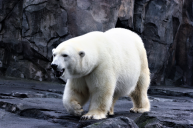Polar bears are facing a steady decline in Canada's Hudson Bay area. According to a recent government report, only 618 bears lived in the area in 2021—a 27% drop from 2016, when 842 polar bears called the area their home. Members of the polar bear population that are affected most are females and cubs. The study says that females must build fat reserves to carry their cubs and expand the population. If they cannot, the population will end with them. In addition, the bears depend on sea ice to hunt for seals, but the Arctic waters are warming faster every year, which means the ice is forming later and melting sooner every year, making hunting difficult.
Conservation scientists estimate that by 2050, the diminishing no-ice-to-ice time frame will likely lead to starvation. The report states, "The observed declines are consistent with long-standing predictions regarding the demographic effects of climate change on polar bears."
While the report talks a lot about ice patterns and the polar bear population decline, the Canadian government doesn't want to put all the blame on the loss of sea ice. The report notes that four of the last five years have had good ice conditions. Another factor they are considering is the migration patterns of the seal population. On top of that, polar bears have changed their migration patterns, moving into neighboring areas.
Polar bears are the biggest carnivores on land, and their migration pattern typically takes them along the Hudson Bay coast in the autumn on their way to the sea ice through the Manitoba province. The large mammal's migration brings millions of dollars to Churchill, a Manitoba town known as "the Polar Bear Capital of the World." As a result, the town's people often leave their car doors unlocked just in case someone needs to take shelter from a passing bear.




